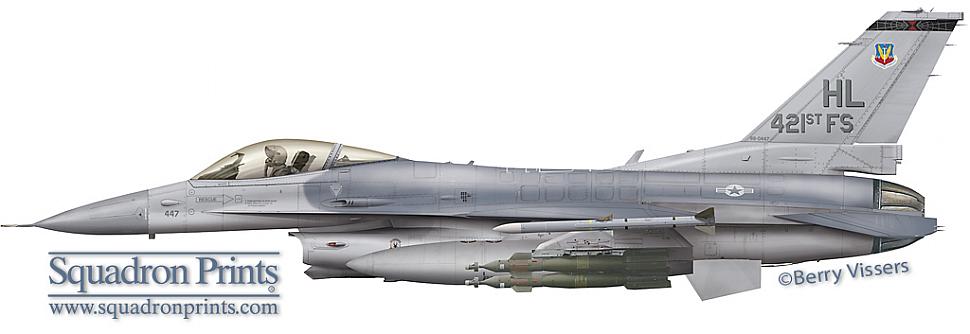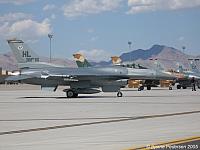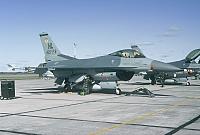 |
421st Fighter Squadron ( USAF ACC)" Black Widows" |
 |
421 FS " Black Widows" ( USAF ACC) | |||
| Status: |
Converted
|
|||
| Version: | F-16C/D block 40 | |||
| Role: | Air Defense, Attack | |||
| Tailband: | Black | |||
| Motto: | Kiss of Death | |||
| Badge: | N/A | |||
|
Converted to the F-35A in 2017.
|
||||
F-16 History
The 421st FS was the second of the Hill AFB units to receive the F-16. New block 1, 5 and 10 airframes came straight from the General Dynamics production line at Fort Worth starting in 1980. Although the squadron wasn’t a training squadron, it did some dedicated training work after all. In November 1981, the squadron deployed to Egypt where it trained Egyptian pilots in exercise Bright Star. Back at Hill AFB, during a time period from July 1st, 1982 till January 1st, 1983 the 421st TFS had trained pilots from Britain, Egypt, and Pakistan as well as USAF pilots. In 1983 the squadron took the job of being the Replacement Training Unit (RTU) from the 34th TFS which became a primary front line operations squadron along side with the already operational 4th TFS. By the beginning of 1984 the 421st TFS dropped the training role completely leaving only the 16th TFTS as the sole training unit at Hill AFB. Now the 421st TFS would be able to go for various deployments including Red Flag.
Later on the squadron was tasked with conventional air-to-ground and attack, although the first aircraft were in fact airframes that still had the small stabs. Since the importance of the squadron for this task, newer block 15 airframes came into the unit quite quickly. By 1983 the squadron was completely converted to the block 15 airframes. The 421st kept flying with these airframes up until 1990. It was then that they started receiving the upgraded block 40 version of the F-16. With this newer version the squadron was able to conduct its missions with even greater accuracy and also added a night-time possibility to it.
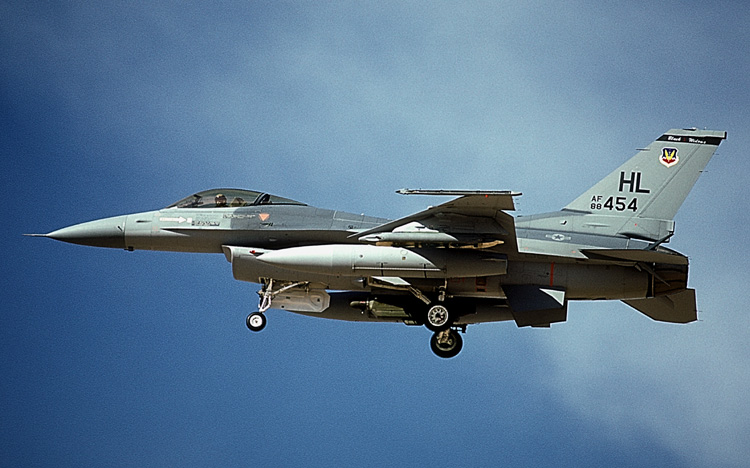
This came into being with the introduction of the Low Altitude Navigation and Targeting Infrared for Night (LANTIRN) pod to the inventory. The squadron started operating this pod in mid 1990 as one of the first USAF squadrons to deploy it in an operational environment. With tensions rising in the Middle East the squadron had to adopt this new weapon system very quickly and had to train in very different scenarios then previously flown in a couple of months time.
Today the 421st is one of the longest operating F-16 units worldwide, together with its sister squadron – the 4th FS – and the Belgian 349 squadron who was the first overseas unit to become operational on the type. It continues to live up to its legacy by deploying numerous aircraft all over the world in different operations.
Aircraft Markings History

The tail consist of a black tailband with the squadron logo and the words 'Black Widows' on both sides contained in it. The 'HL' tailcode (from Hill) is in the center of the tail with the Tactical Air Command logo in between. The serial is underneath the tailcode.
The general lay-out remained the same, but the 'Black Widows' words were removed an replaced by a spider web.
Unit History
- 1943: Activation of the squadron in Orlando, Florida
- 1943: P-70 'Havoc' (part of AAF School)
- 1943: P-70 'Havoc' (Kissimmee Field, Florida)
- 1943: P-70 'Havoc' (Milne Bay [N. Guin.])
- 1944: P-70 'Havoc' (Nadzab [N. Guin.])
- 1944: P-38 'Lightning' (Owi [S. Isl.])
- 1944: P-38 'Lightning' (Tacloban [Ley.])
- 1945: P-38 'Lightning' (part of 86 FW, San Marcelino [Phil.])
- 1945: P-61 'Black Widow' (Clark Field [Phil.])
- 1945: P-61 'Black Widow' (Shima Field [Jap.])
- 1945: P-61 'Black Widow' (Itazuke [Jap.])
- 1945: P-61 'Black Widow' (part of 315 CW)
- 1947: Disbanded
- 1962: Activation of the squadron in George, California
- 1962: F-105D 'Thunderchief' (part of 355 TFW)
- 1964: F-105D 'Thunderchief' (McConnell AFB, Kansas)
- 1965: F-105D 'Thunderchief' (part of 835 AD, Korat AB [Thai.])
- 1965: F-105D 'Thunderchief' (part of 6234 TFW)
- 1966: F-105D 'Thunderchief' (part of 388 TFW)
- 1967: F-105D 'Thunderchief' (part of 15 TFW, McDill AFB, Florida)
- 1967: F-105D 'Thunderchief' (part of 4531 TFW, Homestead AFB, Florida)
- 1967: F-105D 'Thunderchief' (part of 23 TFW, McConnell AFB, Kansas)
- 1969: F-4D 'Phantom II' (part of 36 TFW, Da Nang AB [S. Vietn.])
- 1972: RF-4C 'Phantom II' (part of 432 TRW, Takhli AB [Thai.])
- 1972: F-4E 'Phantom II' (part of 432 TFW, Udorn AB [Thai.])
- 1975: F-4E 'Phantom II' (Clark AB [Phil.])
- 1975: F-4E 'Phantom II' (part of 388 TFW, Hill AFB, Utah)
- 1980: F-16A/B 'Fighting Falcon'
- 1990: F-16C/D 'Fighting Falcon'
- 1991: F-16C/D 'Fighting Falcon' (part of 388 OG)
- 2017: Converted
Deployments
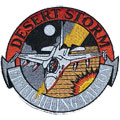 |
' Desert Storm' |
| Mindhad AB, UAE (August 30th, 1990 to March 20th, 1991) | |
| The first of what would be many deployments to the Middle East. The 421st TFS was sent under Operation Desert Shield but stayed for the combat that erupted on January 17th, 1991 during Operation Desert Storm. The unit flew 1,300 combat sorties (1,200 at night) without any losses. | |
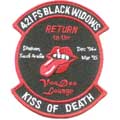 |
' Southern Watch' |
| Prince Sultan AB, Saudi Arabia (December of 1994 to February of 1995) | |
| Operation Southern Watch was an operation which was responsible for enforcing the United Nations mandated no-fly zone below the 32nd parallel in Iraq. This mission was initiated mainly to cover for attacks of Iraqi forces on the Iraqi Shi’ite Muslims. | |
 |
' Southern Watch' |
| Prince Sultan AB, Saudi Arabia (April of 1996 to June of 1996) | |
| This was the squadrons second deployment to ensure the no-fly zone over southern Iraq. The squadron deployed with some 150 personnel for this mission. | |
 |
' Southern Watch' |
| Prince Sultan AB, Saudi Arabia (September 2nd, 1997 to October 25th, 1997) | |
| This time marked a very short stay. It lasted only 7 weeks. Only 120 serviceman were deployed this time. | |
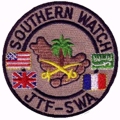 |
' Southern Watch' |
| Prince Sultan AB, Saudi Arabia (August of 1998 to September of 1998) | |
| Once again the 34th FS was sent to the Gulf region to perform an operation Southern Watch mission to guard the southern airspace of Iraq. | |
 |
' Southern Watch' |
| Ahmed Al Jabber AB, Kuwait (September of 1999 to December 9th, 1999) | |
| The last in a row for operation Southern Watch brought the squadron to Ahmed Al Jabber AB in Kuwait. This time the squadron sent up to 300 airman to the region to support the operation. | |
 |
' Northern Watch' |
| Incirlik AB, Turkey (December of 2000 to January of 2001) | |
| Operation Northern Watch was a US European Command Combined Task Force (CTF) who was responsible for enforcing the United Nations mandated no-fly zone above the 36th parallel in Iraq. This mission was a successor to Operation Provide Comfort which also entailed support for the Iraqi Kurds. | |
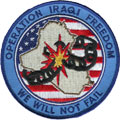 |
' Iraqi Freedom' |
| Al Udeid Air Base, Qatar (May of 2003 to September of 2003) | |
| Operation Iraqi Freedom was initiated in March of 2003 to drive Saddam Hussein from reigning Iraq. Over the next years, multiple units where tasked to perform air cover over Iraq in the wake of this war. | |
 |
' Iraqi Freedom' |
| Balad AB, Iraq (August of 2004 to January of 2005) | |
| This time the 421st deployed with over 300 airman for this mission. A total of over 1,300 sorties were flown with all sorties rated code 1. | |
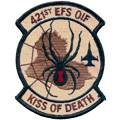 |
' Iraqi Freedom' |
| Balad AB, Iraq (May of 2006 to September of 2006) | |
| Once again the 421st FS was tasked with an Operation Iraqi Freedom mission from Balad AB inside Iraq. A toal of 1,400 sorties were flown in which 6,400 hours were being made. | |
 |
' Iraqi Freedom' |
| Balad AB, Iraq [12 F-16s] (December 29th, 2007 to May of 2008) | |
| About 300 members deployed to Iraq and took over where the 4th FS left off and continue close-air-support for ground troops. This was a regularly scheduled 120 day deployment. All three squadrons rotated through the desert, first the 4th FS in August of 2007, then the 421st FS followed by the 34th FS which all totalled over one year in the desert with the 34th FS returning in October of 2008. Aircraft were shared between the squadron and remained in theatre the entire time. Hill AFB squadrons flew over 5,000 combat missions and was involved in over 200 engagements. Members of the reserve associate unit, the 419th FW also from Hill AFB, joined forces in this deployment. | |
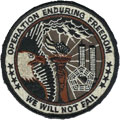 |
' Enduring Freedom' |
| Bagram AB, Afghanistan (May 10th, 2009 to October 8th, 2009) | |
| This marked the first F-16 deployment from the United States to this base. Other coalition forces - like the countries participating in the NATO ISAF mission - already flew from Bagram. This time the USAF decided it was better to group air assetts. | |
 |
' Freedom Sentinel' |
| Bagram AB, Afghanistan (October 28th, 2015 to May 10th, 2016) | |
| Just over 300 members of the squadron deployed to Afghanistan for an eight month deployment. Provided 24 hour support in surveillance and CAS flying over 2800 sorties dropping more than 100 live laser guides bombs. Joining the squadron were other members of the 388th Fighter Wing and about 60 reserve from the 419th Fighter Wing. This marked the last combat deployment for the squadron in the F-16. |
F-16 Airframe Inventory
- All 421 FS F-16s in our F-16 Aircraft Database (past and current aircraft)
- Current 421 FS F-16s in our F-16 Aircraft Database
Photos
Please use this form to add any list any error or omissions you find in the above text.
Note: your comments will be displayed immediately on this page. If you wish to send a private comment to the webmasters, please use the Contact Us link.

